Building strong traps isn’t just about looking good—it can also boost your strength and improve your posture.
But here’s where things get interesting.
Most people approach trap training incorrectly. Either they repeat the same old shrug exercise repeatedly, or they do not train their trap muscles properly.
After analysing research from top strength coaches and testing dozens of exercises, I’ve discovered the BEST trap workout.
That’s what you’ll discover in the next few minutes.
- The best exercises to train the trap muscles include the upper, middle, and lower trapezius muscles.
- What are the common training mistakes?
- How to structure your workouts for maximum trap development.
- Exactly how to train traps for optimal growth
Let’s dive in.
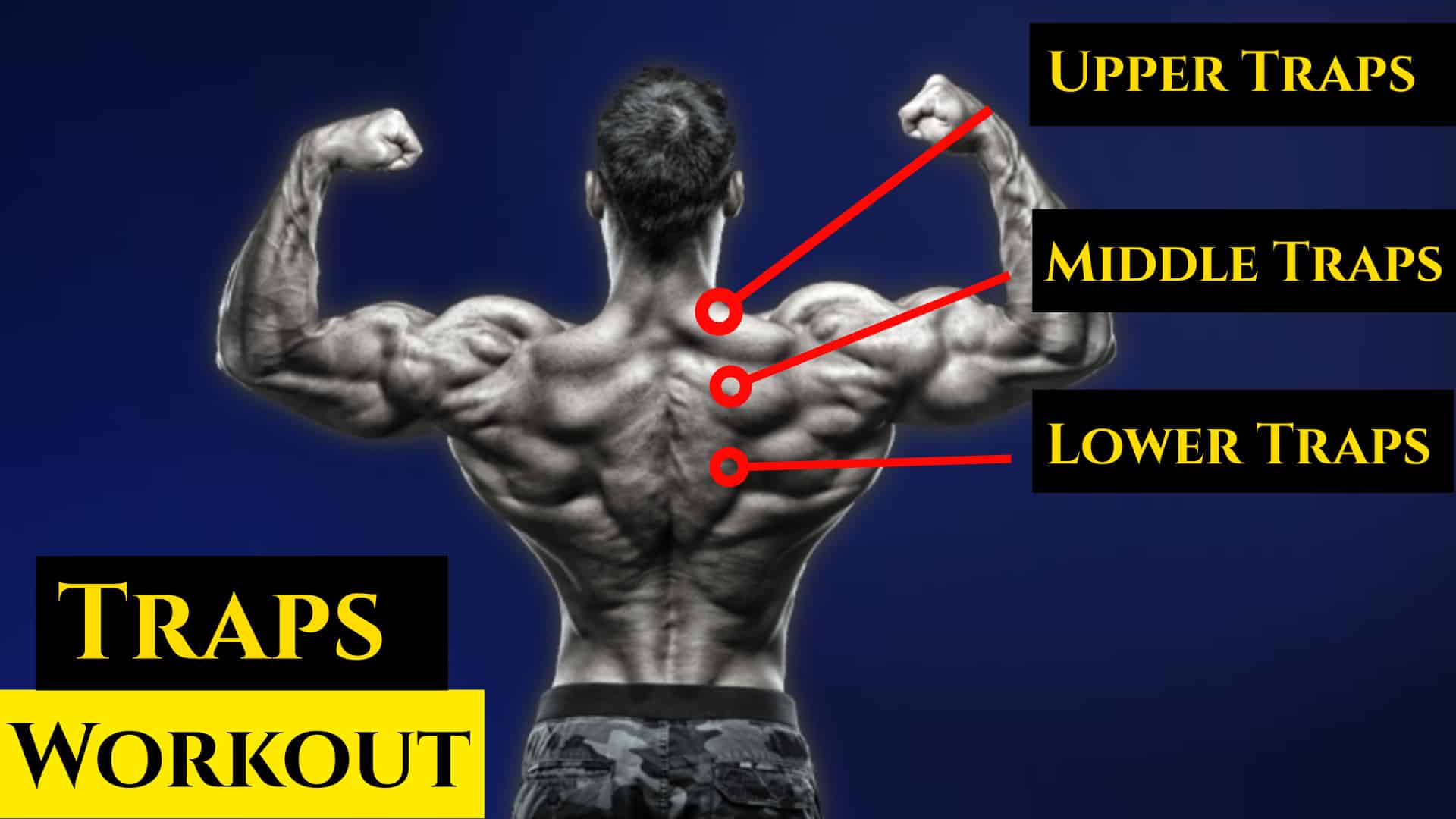
- What Is the Trap Muscle?
- Best Trap Exercises To Build a Bigger Upper Back
- 1. Dumbbell Shrug
- 2. Incline Y-Raise
- 3. Seated Cable Row
- 4. Cable Y Raises
- 5. Dumbbell Farmers Walk
- 6. Barbell Shrug
- 7. Face Pull
- 8. Cable High Row
- 9. Upright Row
- 10. Incline Dumbbell Shrug
- 11. Bent Over Dumbbell Lateral Raise
- 12. Bent Over Barbell Row
- 13. Machine Shrug
- 14. Behind-the-Back Barbell Shrug
- 15. Cable Shrug
- How to Train Upper, Middle, and Lower Trapezius Muscles
- Train the Upper Traps
- Train the Middle Traps
- Train the Lower Traps
- FAQs
- Do shrugs build traps?
- How do I build my trap muscles?
- How long does it take for traps to grow?
- How can I build my trapezius at home?
- Reference
What Is the Trap Muscle?
The trapezius muscle, also known as the trap, is one of the broadest back muscles. It is called such because of its shape: It looks like a trapezoid (a shape with four sides, two of which are parallel).
It is a large muscle that extends from the base of your skull down your spine and out to your shoulder blade. It’s responsible for moving, rotating, and stabilizing your scapula (shoulder blade) and extending your neck.
The trapezius muscle has three distinct regions:
- The upper fibers of the trapezius muscle originate from the back of the skull and attach to the lateral third of the clavicle (collarbone). They are responsible for elevating the shoulders and rotating them inward. They work primarily with shrugging movements.
- The Middle Trapezius originates from the spinous processes of the vertebrae in the upper back and attaches to the acromion process of the scapula. It is responsible for retracting the scapula (shoulder blades) and is worked with rowing movements.
- The lower fibers of the trapezius muscle originate from the spinous processes of the vertebrae in the middle and lower back and attach to the medial border of the scapula. They are responsible for depressing and rotating the scapula upward. They work with exercises that involve raising the arms overhead.
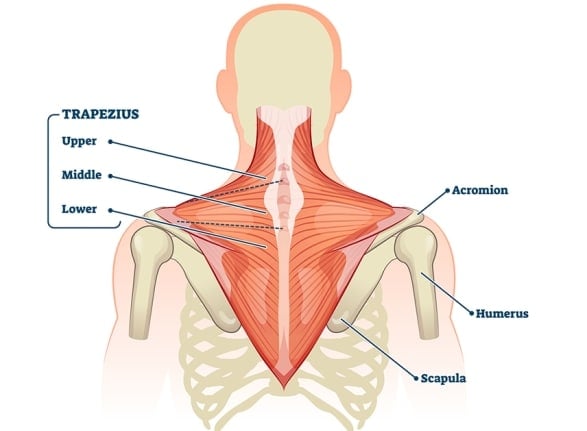
Want to take your gains to the next level? Discover your daily calorie needs with our free TDEE calculator
Best Trap Exercises To Build a Bigger Upper Back
The trap exercises are divided into barbell and Smith machine shrugging exercises, dumbbell shrugging exercises, upright row, cable face pull, and high cable row.
Now, let’s get into the best trap exercises for mass and strength using various types of fitness equipment.
1. Dumbbell Shrug
Dumbbell shrug is one of the most straightforward yet incredibly effective exercises for building upper trap size and strength.
Its primary function during this movement is scapular elevation — in simpler terms, lifting your shoulders straight up.
Electromyography results indicated that the shoulder shrug exercise significantly increased upper trapezius activation compared to the other dumbbell exercises.
A study has shown that shrugging helps relieve shoulder and neck pain.
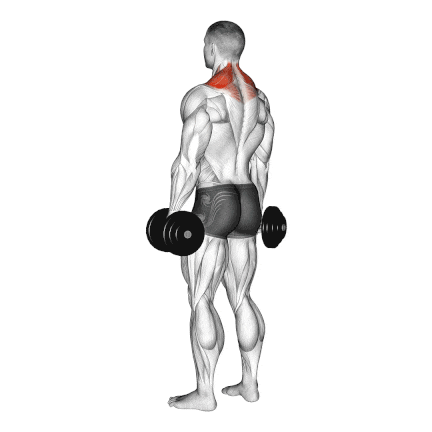
How To Do
- Stand tall with your feet shoulder-width apart. Hold a dumbbell in each hand with a neutral grip (palms facing your body). Let your arms hang naturally at your sides.
- Maintain a slight bend in your knees if that feels more stable, but your torso should be upright.
- Your shoulders should be down and back slightly, not rounded forward. Keep your head in a neutral position, looking straight ahead. Brace your core lightly.
- Without bending your elbows significantly or using momentum from your legs or back, you should shrug your shoulders straight UP towards your ears.
- Imagine you’re trying to touch your ears with the top of your shoulders.
- Hold the contraction at the very top of the movement for a brief pause for 1-2 seconds. Squeeze your traps together.
- Slowly and carefully lower the dumbbells back up to the starting position. Do not just let the weight drop.
- Repeat the movement for the desired number of repetitions, typically 8-15 reps for 2-3 sets.
Tips
- Shrugs are an up-and-down motion, not a circular one. Rolling stresses the shoulder joint unnecessarily and doesn’t effectively increase trap activation.
- Try not to move anything but your shoulders.
- Inhale when you lower the weight and exhale when you lift.
- Limit momentum and excessive jerking or bouncing of the weight.
- Master the form first with moderate weights before lifting the heaviest dumbbells in the gym. You’ll get better results from 12 quality reps than 4 sloppy ones.
2. Incline Y-Raise
Y Raises are a great and easy-to-do shoulder stability exercise that targets both the rotator cuff muscles and your mid and lower traps.
Although the Y Raise is commonly performed on an incline bench, it can be modified to suit your needs and performed in various ways: standing on the floor, on a flat or incline bench, or even on a Swiss ball.
You should add this dumbbell trap workout to your workout regimen.
The Y Raise is usually done on an incline bench, but it can be done in various ways.
- Standing Y-Raise, on the floor Y-raise,
- Y-raise on a flat bench
- Y-Raise on Swiss ball
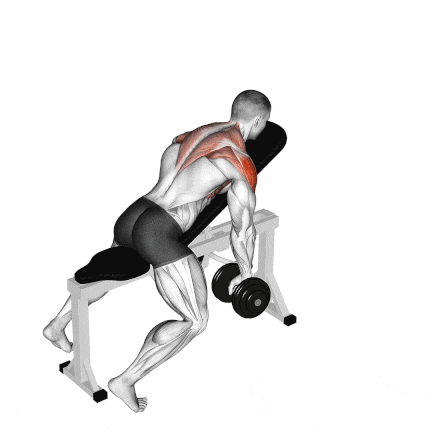
How To Do
- Set an adjustable bench to a low incline. Start around 30 degrees, but you can experiment with angles from 15 to 45 degrees to find where you best feel the target muscles.
- Grab a pair of very light dumbbells. Lie face down on the bench, chest resting on the pad.
- Let your arms hang straight down towards the floor, positioned just outside the width of the bench.
- With arms kept mostly straight (a very slight bend is okay), simultaneously raise both dumbbells out to the sides and slightly forward, forming a “Y” shape relative to your body.
- Raise the dumbbells until your arms are roughly parallel to the floor, or slightly higher.
- Slowly and under control, lower the dumbbells back to the starting position. Allow your shoulder blades to move naturally apart as the weight descends.
Tips
- Start with lightweight. Do not attempt an ego lift; it’s about activating specific muscles. The weight is likely too heavy if you can’t do 15+ controlled reps.
- Don’t shrug upwards with your upper trap. Think about pulling your shoulder blades down your back and bringing them together. Feel the contraction between and below your shoulder blades and in the back of your shoulders.
3. Seated Cable Row
The Seated Cable Rows are a fundamental horizontal pulling exercise. It’s a compound movement that effectively targets the entire back musculature.
Squeezing the shoulder blades together is the most effective way to exercise the rhomboid and mid- and lower traps muscles.
You can do it using different attachments.
It can be done with wide and narrow grips.
- A pronated (overhand) grip tends to target the upper and middle trapezius,
- Meanwhile, a neutral (thumbs up) grip hits the middle and lower trapezius.
- A supinated (underhand) grip switches the focus to the latissimus dorsi.
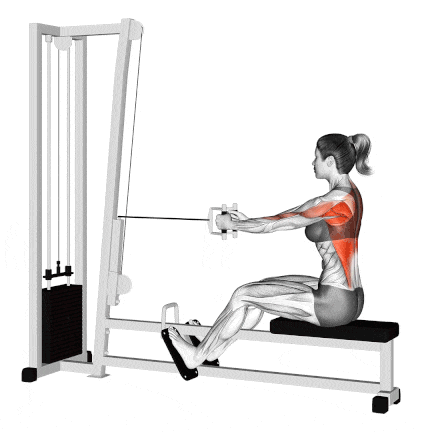
How To Do
- Sit on a seated cable pulley rowing machine with legs slightly bent and feet supported against the crossbar.
- Take hold of the handles with your arms extended and back stretched.
- Pull the handles to come as close to the lower chest/abdomen as possible.
- Thrust your chest out while pulling with your body in an upright position.
- Slowly return the handle to the starting position.
Tips
- Pause briefly when the handles are close to the chest and squeeze your upper back muscles, bringing the scapulae closer.
- Keep your knees slightly bent to avoid knee and lower back pressure.
- Remember, a rounded back is a wrong back. Keep it straight at all times.
- Keep your upper back stationary; don’t move your upper back, back, and forth.
4. Cable Y Raises
The Cable Y Raise is a highly effective isolation exercise for strengthening the rear delts, lower traps, and rotator cuff stabilisers.
Y-raises involve the lower trapezius for scapular upward rotation and depression, aided by the serratus anterior for rotation and protraction. The posterior deltoids and sometimes supraspinatus perform shoulder abduction/flexion. The middle trapezius may assist with retraction, and the rotator cuff stabilizes the joint.
You can do this exercise with one arm at a time, but training both arms equally will help you avoid muscle imbalances and keep everything in harmony.
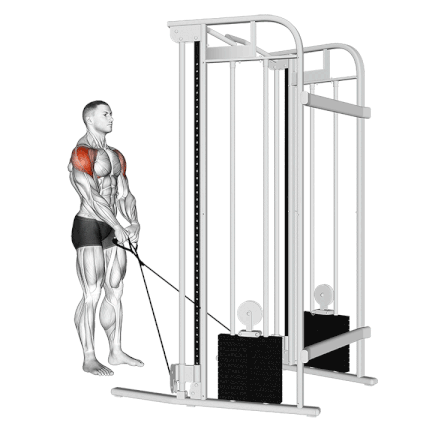
How To Do
- Set up a cable machine with the pulleys set as low as possible. Attach a single D-handle to each cable.
- Grab a D-handle in each hand using an overhand grip (palms facing down).
- Stand facing the cable machine. Take one or two steps back to create tension, ensuring the weight stack is slightly off the pins.
- Your arms should be extended downwards and slightly in front of you. Maintain a slight forward lean from your hips.
- Keep your arms relatively straight (a slight bend in the elbow is fine). Raise both arms simultaneously, making a letter ‘Y’ shape.
- Raise your arms until they are roughly in line with your torso (or slightly above, if comfortable and controlled)
- Avoid shrugging your upper traps excessively towards your ears; the focus is on upward rotation and depression of the scapula’s lower tip.
- Slowly lower your arm back to the starting position. Do 10-12 repetitions for 3 sets.
Tips
- Raise your arms in a wide “Y” shape—roughly at a 45° angle from your torso
- Avoid shrugging your shoulders up to your ears. Keep them relaxed and down.
5. Dumbbell Farmers Walk
This isn’t your typical “lift the weight up and down” exercise. It’s a loaded carry, a functional movement pattern we do in everyday life (carrying groceries, moving furniture), but scaled up with serious weight.
While it’s famous for building killer grip strength, the Farmers Walk is an absolute beast for developing isometric strength and endurance in your traps, core, and shoulders.
This is one of my favourite exercises because it integrates multiple muscle groups and builds real-world strength. While walking with a heavy weight, the traps keep everything stable.
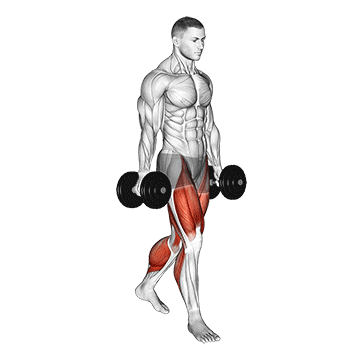
How To Do
- Choose two heavy dumbbells of equal weight. Position them on the floor just outside your feet.
- Hinge at your hips with a slight bend in your knees (like the start of a deadlift). Grip the dumbbells firmly in the center of the handles.
- Once standing, let the dumbbells hang naturally at your sides. Your arms should be relatively straight, palms facing your body (neutral grip).
- Stand tall, pull your shoulders slightly back and down, chest proud, and look straight ahead.
- Begin walking with short, controlled steps. Avoid excessive swinging of the weights. Maintain your upright posture throughout the entire walk.
- Walk for a predetermined distance or time. To finish, safely lower the dumbbells back to the floor by hinging at your hips with a straight back, just like you picked them up.
Tips
- Keep a neutral or straight spine throughout the movement to avoid injury.
- If your posture breaks down, the set is over. You get the most trap activation when you actively resist the weight trying to pull you out of alignment.
- Keep a steady pace. Avoid rushing or “stomping.” Each step should be controlled, with hips level and eyes forward.
6. Barbell Shrug
Barbell shoulder shrug is a popular exercise choice for strengthening your trapezius, upper back, shoulder muscles, neck, and upper arms.
It is one of the best exercises to increase upper back and shoulder hypertrophy when practiced consistently.
A study has shown that shrugging helps relieve shoulder and neck pain. Strengthening your traps helps provide better support to your head and neck by increasing the activation of your shoulder muscles.
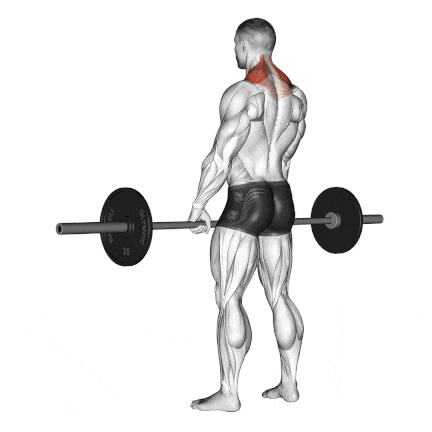
How To Do
- Stand with feet placed shoulder-width apart, knee slightly bent, and core stable.
- Grip the barbell with your hands facing downwards in a pronated grip.
- Raise your shoulders without bending your elbows as far as possible, getting them closer to your ears.
- Hold the contraction and squeeze for a brief second.
- In a controlled and stable manner, lower the weight back down to the starting position.
Tips
- Go as high as possible, but limit momentum and excessive jerking or bouncing of the weight.
- Go full range. Move only the shoulders and keep the rest of the body steady.
- Keep your arms straight and focus on lifting the weight with your shoulders, not your arms.
- Avoid rolling your shoulders forward or backward during the exercise.
7. Face Pull
If I had to select a single exercise that I consider essential for nearly every client, it would undoubtedly be the Face Pull. This exercise effectively targets the rear deltoid and the trapezius muscles, particularly the middle and upper regions.
- As you pull the rope back towards your face, your upper arms move horizontally away from the front of your body. This action primarily trains the rear deltoids.
- Simultaneously, you should pull your shoulder blades together towards your spine. During this motion, the middle Trapezius and Rhomboids power train.
This is one of my favourite exercises. It helps me build a bigger trap and rear delt.
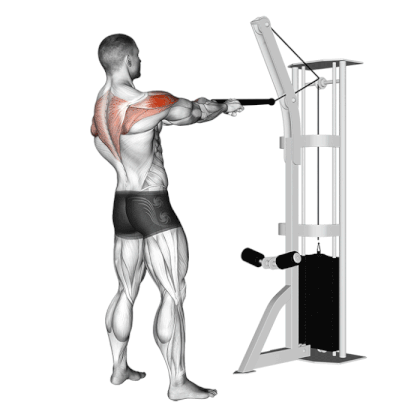
How To Do
- Set up a cable machine with a rope attachment at roughly eye level or slightly higher (this is a good starting point; you can experiment with height later).
- Grab the rope with an overhand grip (palms facing down/towards the floor), placing your thumbs against the ends of the rope.
- Step back from the machine until the weight stack is slightly off the pins, creating tension. Your arms should be extended forward.
- Assume a stable stance (feet shoulder-width, maybe one slightly forward). Keep your chest up, your shoulders relaxed down (not shrugged up initially), and your core engaged.
- Pull the rope directly towards your face, aiming for a point between your nose and forehead.
- As you pull, actively retract your shoulder blades. Continue pulling until the ends of the rope are pulled past your ears, and your hands are near the sides of your head.
- Then, slowly return the rope to the start position and repeat for reps.
Tips
- Stand straight with your feet in a comfortable, balanced stance.
- Think about trying to pinch your shoulder blades as tightly as possible when pulling weight toward your face.
- Your upper arms should be straight out to your sides, with elbows bent
8. Cable High Row
Half kneeling high cable row rope is a tremendous exercise that effectively works many muscles, including the shoulder, back, wing, and middle and lower trapezius muscles.
This exercise gives people with shoulder issues an exercise to get the benefits of rows.
In addition, face pull is one of the most effective corrective exercises for compensating for poor posture and shoulder dysfunction.
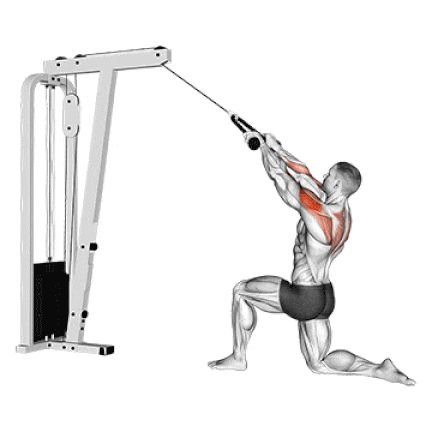
How To Do
- Set up a cable machine with the pulley set high, with the rope attachments
- You can perform this seated, kneeling, or standing – kneeling often provides excellent stability and allows for a good stretch. Let’s describe kneeling.
- Grab it with a neutral grip (palms facing each other).
- Reach up and grab the attachment. Lean back slightly from your hips.
- Initiate the pull by driving your elbows downwards and back. Focus on squeezing your shoulder blades together and pulling them down your back.
- Slowly return to the starting position. Repeat 10-15 reps.
Tips
- Don’t lean backwards to pull the weight towards you.
- Retract your shoulder blades as you pull, squeezing the upper back.
- Experiment slightly with the pulley height to see where you feel the contraction most effectively in your mid/lower back.
9. Upright Row
The upright row is a compound weightlifting exercise that involves multiple joints and simultaneously engages several muscle groups. It primarily targets the deltoids (shoulders) and trapezius, while also working the biceps, forearms, and upper back.
One thing I really like about the upright row is how it challenges your body’s vertical pulling strength.
Most pulling exercises are horizontal (like rows) or overhead (like pull-ups). The upright row fills this middle ground, helping to round out your pulling strength in all directions.
Electromyography results indicated that the shoulder shrug exercise significantly increased upper trapezius activation compared to the other dumbbell exercises.
You can do many variations of the upright row with barbells, dumbbells, cables, and other gym equipment. You can also use different grips. I like the cable upright row.
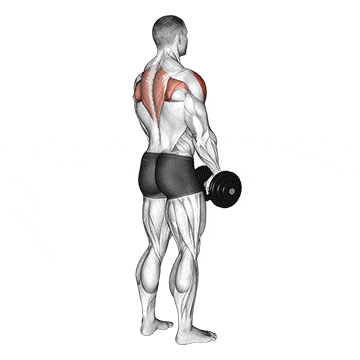
How To Do
- Hold the dumbbells at arm’s length down by your thighs with your palms facing towards you.
- Your grip should be just less than shoulder width.
- Lift the dumbbell and get it as close as possible to chest height using your arms.
- Elevate your shoulders to squeeze your trapezius muscles.
- Now, lower the dumbbell under controlled motion until it returns to its starting position.
- Repeat for 8 to 12 reps.
Tips
- Keep a controlled motion and avoid jerky movements.
- Don’t allow your back to arch as you pull the weight up.
- Avoid shrugging your shoulders upward; the movement should be focused on pulling the elbows up and back.
Know More: Upright Row: Muscle Worked, Form, Benefits, Variations
10. Incline Dumbbell Shrug
The Incline Dumbbell Shrug is a variation of trap dumbbell shrug exercises that strengthen the upper part of the trapezius and neck region and also help to improve posture.
This movement focuses on scapular elevation and retraction, engaging upper and mid-trapezius fibres due to your body’s forward angle.
Because your chest is pressed against the bench, it will be hard to use momentum to lift the weight up.
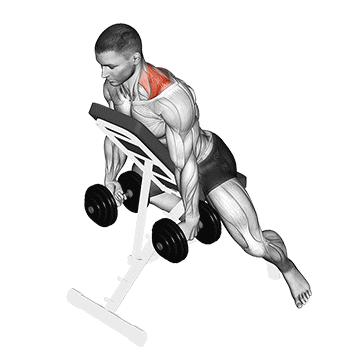
How To Do
- Grab a weight bench and set the incline to roughly 30-45 degrees. Lie face down on the bench, letting your chest rest against the pad. Your feet can be planted on the floor for stability.
- Experiment with the angle! Some people feel it is better slightly flatter (around 30), others steeper (closer to 45). Find what allows you to feel the target muscles working best.
- Hold a dumbbell in each hand with a neutral grip (palms facing each other). Let your arms hang straight down towards the floor.
- Slowly shrug your shoulders up toward your ears.
- At the top, pause momentarily and contract hard through your traps and rhomboids.
- Slowly lower the weights back to the starting position.
Tips
- This exercise often responds well to higher rep ranges, such as 10-20 reps.
- I typically program incline shrugs after heavy compound pulling (like rows). It can also be paired with rear delt exercises.
- Move the dumbbells smoothly and evenly without jerking them at all.
- Keep your arms mostly straight (a very slight bend is fine, but don’t curl the weight), pull your shoulder blades down and slightly BACK
11. Bent Over Dumbbell Lateral Raise
Bent-over raises are an excellent exercise for isolating and working specifically on the rear deltoid, middle, and lower trap muscles. They are a must for complete shoulder muscle development.
Thus, the exercise hit precisely the rear delt and mid-trap head by isolating it.
This exercise can be performed in both a standing and a seated position. I prefer the seated version, as it requires strict movement.
There are many variations of bent-over lateral raises that you can add to your workout routine, each with its unique benefits.
- Dumbbell Bent Over Raise: Enhances shoulder stability with free weights.
- Cable Rear Delt Lateral Raise: Constant tension for efficient muscle activation.
- Incline Bench Rear Raise: Increases stretch and contraction for rear delt development.
- One-Arm Rear Bent Over Raise: Improves symmetry and targets rear deltoid isolation.
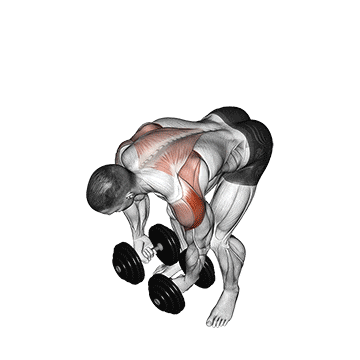
How To Do
- Stand with your feet shoulder-width apart. Hold a dumbbell in each hand with a neutral grip (palms facing each other). Hinge forward at your hips, keeping your back straight and chest up, and keep your back straight and chest up. Y
- Our torso should be roughly parallel to the floor or slightly higher. Let the dumbbells hang straight down in front of us, below our shoulders.
- Keep your elbows bent and lift the dumbbells out to the sides in a wide arc.
- Raise the dumbbells until your upper arms are roughly parallel to the floor.
- Slowly and with control, lower the dumbbells back to the starting position.
Tips
- One of the biggest mistakes people make is swinging their arms or leading with their hands. Instead, keep a soft bend in the elbows and imagine lifting with your elbows to engage the rear delts and mid-traps.
- If you struggle with maintaining form or back position in the standing version, the bench-supported variation is gold standard for strict execution
12. Bent Over Barbell Row
The bent-over barbell row is a compound exercise that trains your traps (particularly the middle and lower fibres) while simultaneously engaging your rhomboids, rear delts, and lats.
As you pull the barbell toward your torso, your scapulae retract by pulling together, activating the trapezius muscles. The upper trapezius acts as a stabilizer, while the middle and lower fibers facilitate the main scapular retraction.
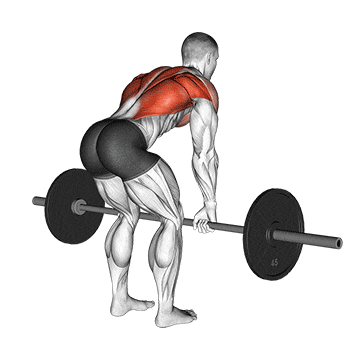
How To Do
- Stand with feet shoulder-width apart. Hinge at your hips, pushing your glutes back.
- Grip the bar with an overhand grip, slightly wider than shoulder width (experiment to find what feels best for your mechanics and target area—wider often emphasizes more upper back/rhomboids, while narrower can feel more lats, but keep it reasonable).
- Your back should be flat, close to parallel to the floor (or at least above 45 degrees, aiming lower as you get more comfortable).
- Your chest should be up, shoulders back, and head neutral (looking slightly ahead or down).
- Exhale and pull the bar explosively towards your lower chest or upper abdomen. Ensure the bar travels in a relatively straight line towards your torso.
- Think about driving your elbows back and squeezing your shoulder blades together and down as the bar comes up.
- Inhale and slowly lower the bar back to the starting position with control.
Read More To Know More: Shrug Exercise: Benefits, Variations, Muscles Used, Tips
13. Machine Shrug
The Shrug Machine, also called the Trap Machine, is a special piece of gym equipment that makes doing shrugs easier and effective. The lever or handles usually align with your shoulders, providing a comfortable grip and a controlled range of motion.
Unlike dumbbells or barbells, the Shrug Machine targets the upper trapezius muscles and minimizes the involvement of other muscle groups. Its ergonomic design lets you focus on muscle engagement, making it a good choice for this purpose.
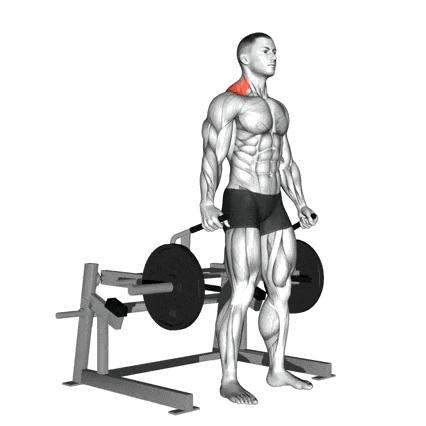
How To Do
- Stand with your feet shoulder-width apart.
- Grip the handles or the lever bars with your palms facing inwards or downwards.
- Start with your shoulders relaxed and arms fully extended.
- Take a deep breath and engage your core. Next, raise your shoulders up towards your ears and squeeze your upper trapezius at the top of the movement.
- Slowly release the contraction and lower your shoulders back to the starting position.
14. Behind-the-Back Barbell Shrug
While the standard front barbell shrug is a staple, the line of pull is slightly altered relative to the shoulder joint and scapulae when the bar is moved behind the body. This results in a more isolated contraction in the upper traps, particularly along the upper-medial fibers.
Some people may feel more comfortable in this position, which may also help them get a stronger, more direct contraction in the upper traps.
It’s a great way to introduce variation and keep your muscles adapting.
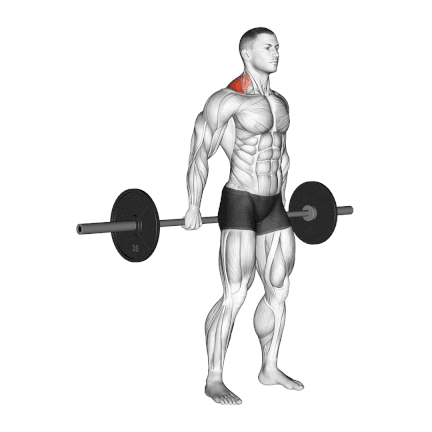
How To Do
- Use a power rack setup where you can unrack the bar from pins set at mid-thigh height behind your back. Alternatively, you can deadlift the bar up behind you if you have good hip mobility and control, but un-racking is safer for heavier weights.
- Stand tall with your feet shoulder-width apart. Hold the barbell behind your back with an overhand grip slightly wider than shoulder-width. Your palms will face backwards.
- Let the bar hang naturally at arm’s length, just behind your glutes/hamstrings.
- Maintain a tall, upright posture, chest up, shoulders back, and a neutral spine. Avoid leaning forward or backwards.
- Take a deep breath, brace your core, and exhale as you powerfully shrug your shoulders straight up towards your ears.
- Keep your arms straight throughout the movement – do not bend your elbows or use your biceps.
- Inhale slowly and with control, lower the weight back down to the starting position.
15. Cable Shrug
The cable shrug is a variation of the traditional shoulder shrug and is recognised as one of the most effective exercises for developing the upper trapezius.
The shrug is an isolated vertical scapular elevation. Your arms remain straight, and all the motion comes from lifting your shoulders directly upward, not backward (a common mistake).
Cables ensure tension at both the top and bottom, maximising time-under-tension (TUT).
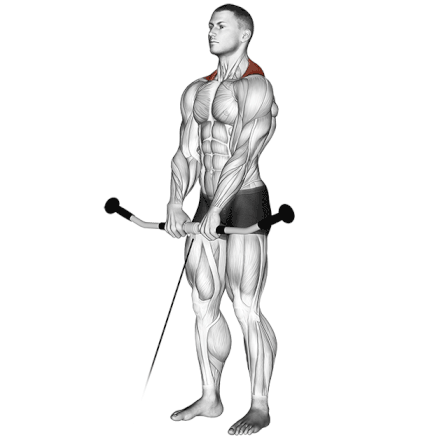
How To Do
- Stand facing a cable machine with a straight bar attachment (my preferred) or two D-handles connected to the low pulleys. Ensure you have enough space to stand tall.
- Grab the bar with an overhand grip, hands slightly wider than shoulder-width. If using D-handles, grab one in each hand.
- Stand tall with your feet shoulder-width apart. Keep your chest up, shoulders slightly pulled back, and look straight ahead.
- Start by shrugging your shoulders straight up to your ears. Move only your shoulders and traps—keep your arms straight and avoid bending your elbows or using your biceps.
- Squeeze your traps hard at the very top of the movement.
- Slowly and with control, lower the weight back down to the starting position.
- Repeat for the desired number of reps.
Tips
- Prevent from rolling your shoulders, as this is an incorrect form and can result in injury.
- Inhale when you lower the weight and exhale when you lift.
- Try adding a pause at the top of your shrug.
- Always select a weight that gives you full body control throughout the movement.
How to Train Upper, Middle, and Lower Trapezius Muscles
The trapezius muscle, commonly known as the “traps,” is a large, triangular-shaped muscle that spans the upper back and neck. It’s divided into three main regions — the upper, middle, and lower traps — each with distinct functions and training requirements.
To build full, three-dimensional traps, you must work on all three areas separately with the right exercises and methods.
Train the Upper Traps
The upper trapezius runs from the base of the skull down to the shoulders and is responsible for scapular elevation, the movement of lifting the shoulders upward.
Key Functions
- Elevates the shoulders
- Assists in neck movement and posture
- Helps stabilise the scapula during arm motion
Best Exercises
- Barbell or Dumbbell Shrugs
- Upright Rows
- Trap Bar Shrugs
- Behind-the-Back Shrugs
Train the Middle Traps
The middle trapezius spans across the upper back and primarily involves scapular retraction—pulling your shoulder blades together. These muscles play a key role in shoulder stability and posture.
Key Functions
- Retracts the scapula (pulls shoulder blades inward)
- Works during rowing and pulling movements
- Supports posture and scapular alignment
Best Exercises
- Bent-Over Barbell Rows
- Seated Cable Rows
- Face Pulls
- Reverse Flys
- Prone Y-Raises
Train the Lower Traps
The lower trapezius originates from the middle of the spine and extends upward to the lower part of the scapula. Its main job is scapular depression and assisting in upward scapular rotation during overhead movement.
Key Functions
- Depresses the shoulder blades
- Assists with overhead lifting mechanics
- Provides scapular and postural stability
Best Exercises
- Prone Y-Raise
- Cable Straight-Arm Pulldowns
- Face Pulls (with scapular depression focus)
- Scapular Pull-Ups
- Incline Dumbbell Shrugs (with arms forward)
FAQs
Do shrugs build traps?
The primary muscle group activated during shrugs is the upper trapezius muscles. Shrugs are a great way to strengthen your upper back muscles, build traps, and improve posture.
How do I build my trap muscles?
To build bigger, stronger traps, you should add the exercises mentioned above to your upper body training sessions.
The upper traps can be developed through common exercises such as shrugs and upright rows, while the mid-traps can be created by pulling the shoulder blades together.
How long does it take for traps to grow?
It is important not to underwork or overwork your traps to achieve the best results. For most people, two trap workouts per week are the ideal amount.
Each session focused on traps should last between 20 and 30 minutes. Resting for 36 to 48 hours before training the trap muscles again is best.
How can I build my trapezius at home?
You can do many exercises at home to build your traps if you invest in a good set of dumbbells. Try shrugs, upright rows, one-arm rows, farmer’s carries, military presses, and bent-over dumbbell lateral raises.
Which is your favorite exercise to train your traps? Please let us know in the comments below.
STAY FIT, LIVE A HAPPY AND HEALTHY LIFE
Reference
- Schoenfeld, Brad MSc, CSCS; Kolber, Morey J PT, PhD, CSCS; Haimes, Jonathan E BS, CSCS: The Upright Row: Implications for Preventing Subacromial Impingement. Strength and Conditioning Journal: October 2011 – Volume 33 – Issue 5 – p 25-28
- Ronai, Peter MS, CSCS, RCEP: Exercise Modifications and Strategies to Enhance Shoulder Function. Strength and Conditioning Journal: August 2005 – Volume 27 – Issue 4 – p 36-45
- McAllister M, Schilling B, Hammond K, Weiss L, Farney T. Effect of grip width on electromyographic activity during the upright row. J Strength Cond PMID: 22362088 DOI: 10.1519/JSC.0b013e31824f23ad
- Cools AM, Witvrouw EE, Declercq GA, Danneels LA, Cambier DC. Scapular muscle recruitment patterns: Trapezius muscle latency with and without impingement symptoms. Am J Sports Med 31: 542–549, 2003.
- Int J Environ Res Public Health. Trapezius muscle timing during selected shoulder rehabilitation exercises. 2021 Jun 14;18(12):6444. doi: 10.3390/ijerph18126444.PMID: 34198674
- Lorenzetti S, Dayer R, Pluss M, List R. Pulling exercises for strength training and rehabilitation: movements and loading conditions. J Funct Morphol Kinesiol. 2017;2(3):33. doi:10.3390/jfmk2030033
- Effects of Lower Trapezius Strengthening Exercises on Pain, Dysfunction, Posture Alignment, Muscle Thickness and Contraction Rate in Patients with Neck Pain; Randomized Controlled Trial

Manish is a NASM-certified fitness and nutrition coach with over 10 years of experience in weight lifting and fat loss fitness coaching. He specializes in gym-based training and has a lot of knowledge about exercise, lifting technique, biomechanics, and more.
Through “Fit Life Regime,” he generously shares the insights he’s gained over a decade in the field. His goal is to equip others with the knowledge to start their own fitness journey.
